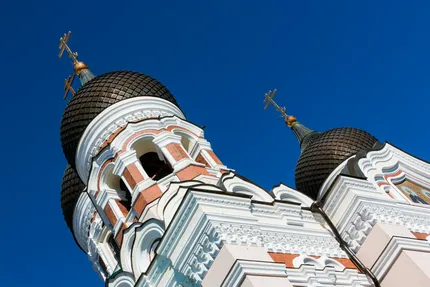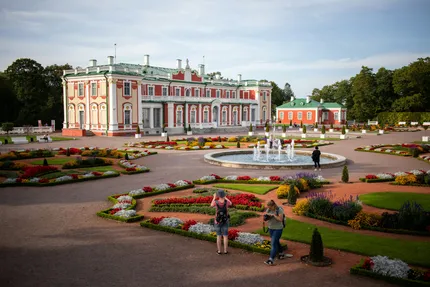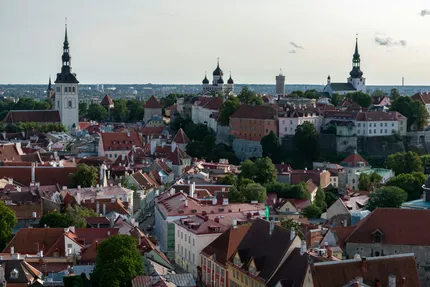CityTouring

City trip to Tallinn
EstoniaTallinn, the capital of Estonia, is a city where medieval charm meets modern innovation. Nestled along the Baltic Sea, it boasts a beautifully preserved Old Town, a UNESCO World Heritage site, with cobblestone streets and Gothic spires that make you feel like you've stepped back in time. Beyond its historical core, Tallinn presents a vibrant cultural scene with a variety of museums, galleries, and music festivals reflecting its rich history and contemporary culture.
The city is also known for its burgeoning tech scene, earning the nickname 'Silicon Valley of Europe.' Visitors can explore the creative district of Telliskivi, filled with stylish cafes, boutiques, and street art, or take a stroll in the lush Kadriorg Park with its impressive palace. Tallinn combines history with a progressive spirit, making it a fascinating destination for travelers.
Full travel plans for a city trip to Tallinn

Tallinn Old Town
Tallinn's Old Town is a UNESCO World Heritage site renowned for its well-preserved medieval architecture. Visitors can wander through narrow cobblestone streets, explore historic sites like the Town Hall Square, and admire Gothic churches and merchant houses. The area is vibrant with cafes, boutiques, and artisanal craft shops, offering a glimpse into Estonia's rich history and culture.

Alexander Nevsky Cathedral
The Alexander Nevsky Cathedral in Tallinn is a stunning example of Russian Revival architecture, located atop Toompea Hill. Built between 1894 and 1900, it features ornate interiors with icons and mosaics. This Orthodox cathedral, with its striking onion-dome, is not only a place of worship but also a historical symbol, reflecting Estonia’s past under Russian influence.

Kadriorg Palace
Kadriorg Palace, situated in Tallinn, Estonia, is an exquisite baroque palace built by Peter the Great in the early 18th century for his empress Catherine I. It now houses the Estonian Art Museum's foreign collection, featuring European and Russian art from the 16th to 20th centuries. Surrounded by beautifully landscaped gardens, it offers a serene and picturesque retreat in the heart of the city.
Tallinn is an ideal destination for history buffs and culture enthusiasts who will appreciate its well-preserved medieval architecture and rich heritage. With its burgeoning tech scene, it's also appealing to tech-savvy travelers interested in innovation and digital culture. The city's compact size makes it perfect for explorers who enjoy walking and discovering charming alleyways and hidden gems.
Foodies will find delight in the abundant traditional Estonian eateries as well as contemporary fusion restaurants. Families will enjoy the ease of access to attractions and the variety of activities available, from museums to hikes in surrounding parks. With its fusion of history, culture, and modernity, Tallinn offers a rewarding experience for the curious and adventurous traveler.
Three top reasons for a city trip to Tallinn
- Explore Tallinn's remarkable Old Town, a UNESCO World Heritage site, known for its cobbled streets, medieval architecture, and vibrant history dating back to the Hanseatic League era.
- Discover the unique blend of modernity and tradition in Tallinn's cultural scene, featuring innovative tech hubs, contemporary art galleries, and traditional Estonian music festivals year-round.
- Experience picturesque views from Toompea Hill, offering panoramic sights of Tallinn's skyline, the Baltic Sea, and nearby landmarks, providing a breathtaking experience for photography enthusiasts.

Best time to visit Tallinn
The best time to visit Tallinn is from late spring to early autumn, specifically from May to September. During these months, the weather is mild, and many outdoor festivals bring the city to life, providing a lively backdrop for exploration.
More activities and things to see in Tallinn:
Toompea Castle
Toompea Castle, located in Tallinn, Estonia, is a historic and architectural highlight that dates back to the 9th century. Today, it houses the Riigikogu, Estonia's parliament. The castle features a unique blend of medieval fortifications and Baroque architecture, with its most distinctive feature being the pink-colored Toompea Castle's Governor's House. Visitors can enjoy panoramic views of Tallinn from the castle grounds.
Kumu Art Museum
The Kumu Art Museum in Tallinn, Estonia, is a key cultural site, showcasing Estonian art from the 18th century to contemporary pieces. As part of the Art Museum of Estonia, it offers rotating exhibitions and a rich permanent collection, housed in a striking modern building. Kumu also engages visitors with educational programs and creative workshops.
Seaplane Harbour
Seaplane Harbour, located in Tallinn, is a maritime museum housed in a historic seaplane hangar. Visitors can explore interactive exhibits, including a 1930s submarine, icebreaker Suur Tõll, and naval artillery. The museum offers insights into Estonia's maritime history with engaging displays, simulators, and audiovisual technologies, making it a fascinating experience for both history enthusiasts and families.
Tallinn TV Tower
The Tallinn TV Tower, standing at 314 meters, is the tallest building in Estonia. It offers panoramic views of Tallinn and the surrounding areas. Visitors can enjoy an interactive exhibition about Estonia's achievements and innovations, and for the adventurous, there's an outdoor terrace at 175 meters where you can experience the Open Deck Walk.
Estonian Open Air Museum
The Estonian Open Air Museum in Tallinn offers a glimpse into rural Estonian life from the 18th to the 20th centuries. Set in a scenic forest park, this expansive museum features traditional farm buildings, windmills, and a wooden chapel. Visitors can experience historical crafts, taste local foods, and enjoy cultural events, making it a fascinating, interactive exploration of Estonia's heritage.
St. Olaf's Church
St. Olaf's Church, located in Tallinn, Estonia, is renowned for its impressive architecture and history. Once the tallest building in the world during the Middle Ages, its towering spire offers stunning views of Tallinn's skyline. Originally built in the 12th century, the Gothic church is a symbol of the city's resilience, having been rebuilt multiple times due to lightning strikes.
Getting around in Tallinn
Tallinn is a very walkable city, especially within the Old Town, where the charming cobblestone streets are best explored on foot. Public transportation is efficient, comprising buses, trams, and trolleybuses that reach most parts of the city. The system is operated by Tallinn Transport Department and is free for city residents, although tourists need to purchase e-tickets or use contactless payments. The recent expansion of the tram network makes it an excellent option for visitors, alongside bike-sharing schemes that operate during the warmer months. Driving within the city can be challenging due to narrow streets and limited parking. At the same time, cycling paths are continuously improving to facilitate safer bike travel around the city. To fully enjoy all Tallinn has to offer, a combination of walking, cycling, and public transport is recommended, although a car might be necessary for day trips outside the city limits to explore the Estonian countryside and coastal areas.
Getting to Tallinn
Traveling to Tallinn is convenient thanks to multiple transport options. The nearest airport, Lennart Meri Tallinn Airport, is located just four kilometers southeast of the city center. It offers a variety of international flights from major European cities, including direct connections to London, Frankfurt, Helsinki, and Amsterdam, making it easy to fly into the city. For travelers preferring overland travel, Tallinn is well connected to neighboring countries via long-distance bus services, with Lux Express and Ecolines offering regular routes to cities such as Riga and Vilnius. Passenger ferries also provide routes across the Gulf of Finland to Helsinki, ensuring a scenic and efficient journey. Overall, Tallinn’s location on the Baltic Sea and its transport connections make it readily accessible from various European locations.